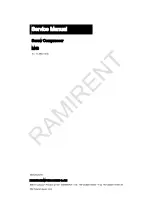
BSS Audio
DPR-402 User Manual v3.0
Page 17
point, with the result that frequencies below the filter cut-off point are excluded.
Once excessive amounts of frequency are detected compression will commence,
but only on those high frequencies program components that initially caused the
compressor to act.
The type of de-essing to be used in a particular situation will depend largely on the
program type and whether the input to the compressor is a mix of sibilant sounds
and other program material, or exclusively the sibilant sound. HF only de-essing
will generally be used when processing a mix of program, whereas broadband de-
essing will be acceptable when processing only the sibilant sound.
It should be realised that this technique is very different from simple equalisation,
since equalising a sibilant vocal by cutting high frequencies would result in loss of
high frequency content at all times. De-essing has no effect whatsoever on the
signal, except at the moment of sibilance, and then the effect is only of overall
level change. There is no change in the general frequency response, yet sibilance is
controlled.
12
.2 Broadband De-essing and controls
Broadband de-essing can be achieved either simultaneously with normal
compression on the same channel of the
DPR-402
, utilising DE-ESS and FREQ
controls, or exclusively on the one channel by setting the MODE switch to DE-ESS
WIDE, and utilising the compressor section controls.
In utilising the controls no other compressor controls will be required. If no
compression is being used, the ratio or threshold controls should be set to OUT.
The frequency control should be set to coincide with the lowest frequency of the
sibilance, and the de-ess control be used to give the required amount of gain
reduction. The maximum amount of reduction available in this mode is 20dB. The
dynamic settings for this compression are set automatically by the unit, and are
optimised for general vocal work.
The green and orange LEDs above the de-ess control provide a simple indication of
the degree of de-essing, with the green LED indicating the start of the operation
and the orange LED indicating approximately 15dB of gain reduction.
Having only a frequency and level control for this broadband de-essing function
provides a very simple and effective way of treating general sibilant vocal signals,
when processed on their own.
Should the need for more comprehensive control of the de-essing function arise,
then the main compressor section can be configured to operate as a dedicated de-
esser by operating the mode switch. The amount of gain reduction can then be
extended down to 30dB if required, and this gives full control over the dynamic
settings, as in normal compression.
















































